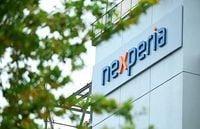The global auto industry, already battered by years of supply chain turbulence, found itself grappling with another crisis this fall—a standoff over a single, little-known chipmaker, Nexperia, that sent shockwaves through car factories from Mexico to Germany. But after weeks of halted production lines, diplomatic sparring, and mounting anxiety among automakers, there are finally signs that the worst may be over—at least for now.
On November 9, 2025, China’s Commerce Ministry announced it would grant exemptions to export controls on Nexperia chips for civilian applications, a move aimed at relieving acute supply shortages for carmakers and their suppliers, Reuters reported. The decision marks the strongest signal yet that Beijing is prepared to ease the pressure on the global auto sector, which has been reeling from a sudden cutoff in chip supplies after the Dutch government took control of Nexperia in late September.
The saga began when the Dutch government, citing national security concerns and “serious governance shortcomings,” invoked a rarely used World War II-era law to seize effective control of Nexperia, a Dutch-headquartered but Chinese-owned semiconductor manufacturer. Officials in The Hague said they acted to prevent the loss of crucial technological know-how, fearing that Nexperia’s parent company, China’s Wingtech Technology, was planning to move European production to China—potentially jeopardizing Europe’s economic security, according to The Associated Press.
The Dutch move came just weeks after the U.S. government expanded its “entity list” to include Wingtech and its subsidiaries, including Nexperia, over national security risks. American officials reportedly told the Dutch government that Nexperia’s Chinese CEO, Zhang Xuezheng, would need to be replaced to avoid further trade restrictions. A Dutch court subsequently granted the ministry’s request to oust Zhang, deepening the boardroom turmoil.
For the global auto industry, the timing couldn’t have been worse. Nexperia, spun off from Philips Semiconductors and acquired by Wingtech in 2018 for $3.6 billion, is a key supplier of simple, so-called “discrete” semiconductors—chips that perform single functions like controlling LED headlights, managing electric vehicle batteries, or operating anti-lock brakes. While Nexperia accounts for only about 5% of the automotive silicon discrete market by revenue, its share in terms of chip volume is much higher, according to S&P Global Mobility analysts. Automakers from North America to Japan and South Korea rely heavily on Nexperia’s components, which can number in the dozens or even hundreds per vehicle.
The company’s sprawling manufacturing footprint only heightened the disruption. Nexperia operates wafer fabrication plants in Britain and Germany, but about 70% of its finished product capacity comes from its assembly and testing center in Guangdong, China. When Beijing responded to the Dutch takeover by blocking exports of Nexperia chips from its Chinese plant in Dongguan, the impact was immediate and severe. Honda, for instance, was forced to halt production at its Mexican factory making the popular HR-V crossover for North America, while other automakers scrambled to dip into their emergency chip stockpiles.
Ford CEO Jim Farley called the situation “an industrywide issue,” warning that “a quick breakthrough is really necessary to avoid fourth quarter production losses for the entire industry.” General Motors CEO Mary Barra echoed those concerns, stating, “We have teams working around the clock with our supply chain partners to minimize possible disruptions.” Nissan’s Ivan Espinosa told CNBC that the company was setting aside a 25 billion yen ($163 million) provision to absorb the impact of the Nexperia crisis, and Mercedes-Benz CEO Ola Kallenius described his company as “scurrying around the world to look for alternatives.”
European carmakers were no less alarmed. The European Automobile Manufacturers’ Association noted that members including BMW, Renault, Volkswagen, and Volvo had been forced to rely on reserve chips, warning that assembly lines could grind to a halt if supplies ran dry.
The geopolitical stakes were just as high. The dispute placed Europe squarely between Washington and Beijing’s ongoing battle for technology supremacy. As China’s Commerce Ministry put it, the Netherlands’ actions had created “turmoil and chaos” in the global chip supply chain. In response, the ministry repeatedly urged the European Union to “further intensify” its efforts to persuade the Dutch government to reverse its seizure of Nexperia. “China welcomes the EU to continue leveraging its influence to urge the Netherlands to promptly rectify its erroneous actions,” the ministry said, according to Reuters.
Amid the diplomatic wrangling, there were glimmers of hope. A high-profile meeting between U.S. President Donald Trump and Chinese President Xi Jinping on October 30, 2025, paved the way for Beijing to begin accepting applications for export exemptions, part of a broader U.S.-China trade truce. The White House announced that China would ease the export ban, and China’s Commerce Ministry soon confirmed that exports would resume for civilian applications.
Still, the situation on the ground remained tense. Nexperia’s Chinese unit suspended shipments of wafers used to make chips to its own factory in China after October 13, 2025, raising concerns about the quality of any chips produced there. Nexperia’s headquarters pushed back, accusing the Chinese unit of “ignoring the lawful instructions” of its global management and refusing to pay for the wafers. “We can’t guarantee the quality of any chips delivered from our China plant since Oct. 13,” the company said in a statement.
Despite the logistical snags, signs of progress continued to emerge. On November 8-9, 2025, the European Union’s trade commissioner Maros Sefcovic noted “encouraging progress,” writing on X (formerly Twitter) that China’s Commerce Ministry had confirmed “further simplification” of export procedures for Nexperia chips to the EU and global customers. In Beijing, the ministry also agreed to a Dutch request to send representatives for consultations, though it pointedly noted that the Netherlands had yet to take concrete action to restore the global semiconductor supply chain.
For automakers, the resumption of chip shipments couldn’t come soon enough. Honda received word that deliveries from China had resumed and expects to restart production at its Celaya, Mexico plant—the facility can churn out up to 200,000 vehicles a year—during the week of November 21, 2025. As Dutch Economics Affairs Minister Vincent Karremans put it, “The Netherlands trusts that the supply of chips from China to Europe and the rest of the world will reach Nexperia’s customers over the coming days.”
Yet for all the relief, lingering questions remain. The dispute over Nexperia’s ownership and operations is far from resolved, and bilateral ties between China and the Netherlands—and by extension, the European Union—are likely to remain strained. As the world’s automakers have learned, even the simplest chips can become the linchpin in a complex, high-stakes geopolitical game.





